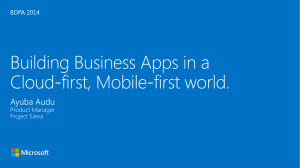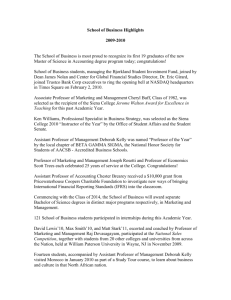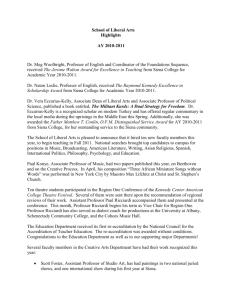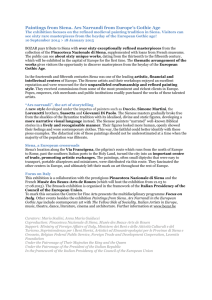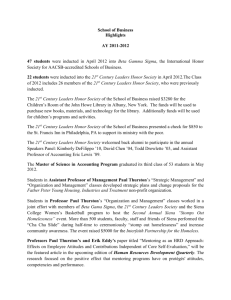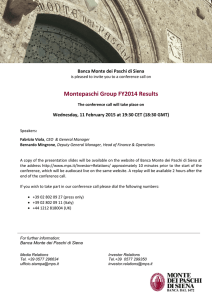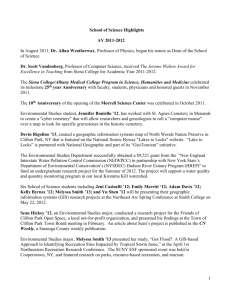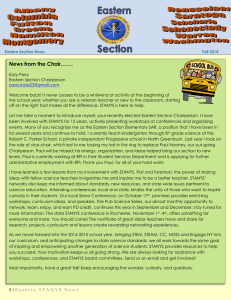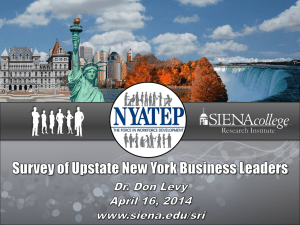4:30- 5:20 PM - Eastern STANYS
advertisement
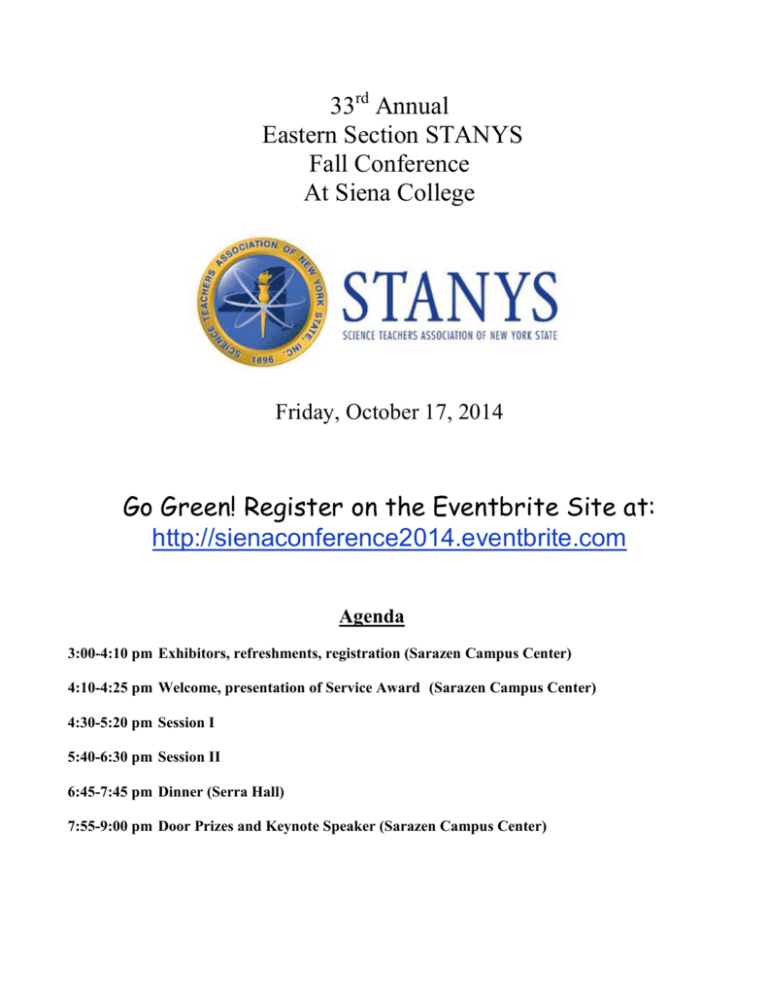
33rd Annual Eastern Section STANYS Fall Conference At Siena College Friday, October 17, 2014 Go Green! Register on the Eventbrite Site at: http://sienaconference2014.eventbrite.com Agenda 3:00-4:10 pm Exhibitors, refreshments, registration (Sarazen Campus Center) 4:10-4:25 pm Welcome, presentation of Service Award (Sarazen Campus Center) 4:30-5:20 pm Session I 5:40-6:30 pm Session II 6:45-7:45 pm Dinner (Serra Hall) 7:55-9:00 pm Door Prizes and Keynote Speaker (Sarazen Campus Center) Session I: 4:30- 5:20 PM A. STEM Kits for Elementary Teachers. Crystal Perno, NYS Master Teacher, Saratoga Springs High School. Charlotte Naples, NBCT, NYS Master Teacher, Mars Maven Ambassador, Saratoga Springs High School STEM kits for Grades 1, 3 and 5 will be presented. Elementary. Siena 105 B. Engineering Design Meets Nursery Rhymes. Fred Pidgeon, Past President, STANYS. Participants will design STEM related projects that their students will then design to bring fairy tales and nursery rhymes to life. Elementary. Siena 106 C. Learn About Wee Beasties. Dr. Dorothy Matthews, The Sage Colleges. See how you can help students learn about tiny life forms: the wee beasties! Come away with new teaching ideas about earth’s oldest critters. Elementary. Siena 117 D. Strategies that Promote Student Engagement. Becky Remis, STANYS DAL Earth Science. Schalmont High School: Kate Perry, Chair-Eastern Section, Elementary SAR; Jennifer Gecewicz, Intermediate SAR; Maria Russo, Director-Eastern Section. How do you keep students behaviorally and cognitively engaged in your science class? Successful instructional strategies and teacher attitudes that answer this question will be shared. This session will be especially useful for new teachers as well as anyone looking for a fresh perspective! General. Siena 119 E. Flipping for Science. Paul D. Levin, Galway High School. Interested in flipping your classroom? Come hear how you can! Hear how I got started, mistakes to avoid and how you can start too. General. Siena 121 F. Professional Development Remix. Jody Suprenant, Fort Edward UFSD, NYS Master Teacher. We’ll learn how to improve STEM literacy and communication, organize and share media resources, and amp up your Domain 4 by creating your own PD home brew using social media. Siena 123 G. Field Camp at Mammoth Cave. Fran Lohnes, NBCT, Saratoga Springs High School and Sherry Riese, Saratoga Springs High School. Join us to hear about how we spend a week last summer participating in research and exploring parts of Mammoth Cave that the public never gets to see. Learn about what field experiences are available for teachers next summer with GSA Geoventures (Earth Science, Biology, Environmental, and K-12) Siena 122 H. Classroom Methods Demo Derby. Laura Van Glad, Jefferson Central School, Eastern STANYS SAR Earth Science. Everyone has quick tips and clever ideas to manage their classroom. Come learn about mine and tell about yours. Bring a sample/picture (flash drive/e-mail attachment). General. Siena 120 I. Regarding Insects. Gerald Dievendorf, President, Field Research and Scientific Studies. General information regarding entomology. Why do an entomology project? How to incorporate live specimens in the classroom. Ideas for projects. RB 250 J. Status of Science Education Reform in New York State. Bruce Tulloch, Participating Professor, Union Graduate College. This session will review the results of the Thirteenth State Science Education Summit held in July, 2014 and indicate the efforts being made to advance science education reform in the current school year. General. RB 202 K. Motivating our students to learn chemistry. Bill Brown, Eastern STANYS Vice-Chairperson, Chemistry teacher, Queensbury High School. How can we get our chemistry students intrinsically motivated to learn chemistry? A discussion on the carrot/stick approach and what might be better. Chemistry. RB 302 L. Essentials of Chemistry in the Sciences. William Roome, STANYS Chemistry DAL, Madrid-Waddington Central School District. This workshop is designed to enhance K-12 science education by introducing and embellishing the central role of chemistry in all the sciences and in our everyday lives. Teachers will participate in many demos. Chemistry. RB 328 M. 5-Minute Physics Lessons. Paul Federoff, STANYS DAL Physics, Burnt-Hills-Ballston Lake High School. 5minute physics lessons that you might not traditionally do, but every student should be exposed to that comes through your class. Physics. RB 412 N. Holy Flying Gourds! How to Organize and Run a Pumpkin Chunkin Event Tony Malikowski, Eastern STANYS Physics SAR. Learn the logistics for organizing a safe and entertaining target shooting competition for siege engines. Machine design, community involvement, and curricular integration will be discussed. Physics. RB 428 O. Teach Like a Scientist. Mrs. Jane King, Questar III: Summer Research Institute; Nichole Mantas, Lansingburgh High School. Come learn about the Questar III Summer Research Institute. Fellows in the program work alongside local scientists for two summers to develop skills and content knowledge to use with your students for a more rigorous, inquiry-based classroom. Applications will be available for Summer 2015. General RB 208 P. Activities for the Water Planet. Joan Wagner, Eastern STANYS SAR for Informal Learning, Focus on Learning. Water’s properties, watersheds, wetlands and more. This workshop is filled with many hands-on activities for MS and HS. After the presentation, all supplies and equipment will be given away. To ensure there is enough time to do all activities, this is a double session. Water is articulated strongly to all standards. RB 238 Q. Eco-Choices: An Environmental Game about decision-making and tradeoffs. Sandra Fischer, Chatham High School. Developed by the Cary Institute, this game involves challenges for students to balance both the environmental and economics in their decision-making. Siena 125 R. Starlab Inflatable Planetarium with Astronomy Educator. Elissa Kane, The Dudley Observatory. It’s best to learn astronomy in a 3-d based format. In this interactive/planetarium program, students explore orbital motions that cause predictable patterns in the phases of the moon, seasons and changing constellations in the night sky. Sarazen Center Session II 5:40-6:30 pm S. A Bubble? An Elementary Inquiry Based and STEM Unit. Katy Perry, Chair- Eastern Section, Eastern STANYS Elementary SAR. Explore bubble physics and fun! Students delve into bubble properties, examine forces that hold them and engineer the best bubbles. Aligned to CC and NGSS. Elementary. RB 238 T. Recycling and Beyond. Debbie Jackson, Environmental Program Specialist 2, New York State Department of Environmental Conservation. How to develop and expand a school recycling program. I will also provide classroom activities you can do with your students. Grades K-8. Siena 121 U. Fun with Forces and Motion; an Inquiry Based Approach for Middle Schoolers. Roy Moffitt, Antioch University New England. Samples from a NextGen science standards curriculum. How many forces did it really take to have an apple fall on Sir Isaac Newton’s head? Siena 123 V. Game-based Learning as a Way to Teach Climate Literacy. Laura Tedesco, NBCT, Troy High School and Megan Fung, PhD candidate, RPI. Learn how earth science students created interactive board games in order to explore how humans impact our environment and address future implications of climate change. Earth Science. Siena 125 W. How to Put NASA’s Challenger Learning Center in Your Classroom. Charlie Kuenzel, Challenger Learning Center Board Member, Challenger Learning Center of Tech Valley. Learn how classroom teachers can use the Challenger Learning Center to bring programs that are space themed, that support problem-solving and teamwork into their classes. Earth Science. Siena 122 X. Krazy Traits. Fred Pidgeon, Past President STANYS. The participants will build an animal from a kit that brings Punnett squares and genetics to life. Biology. Siena 106 Y. Fruit Flies, Oil Spills, and More: Creative Activities in Biology. Nichole Mantas, Lansingburgh High School. Explore several hands-on, inquiry based lab experiments for all levels of biology. Investigate DNA, RNA, and proteins by building mutant fruit flies; investigate the best way to clean up an oil spill, and more. Biology. RB 208 Z. Global Harmonization for Chemical Hazard Communications. Ann Klotz, Siena College. Global Harmonization System, GHS, is a new structure for communicating chemical hazards. Many chemical labels are already displaying the new hazard symbols. The format of material safety data sheets is also changing. The presentation will include an overview GHS and how to find information important to you on labels and safety data sheets. Chemistry RB 302 AA. Chemistry using the Project Based Learning (PBL) Model. Diana Weldon, Tech Valley High School. Have you ever been asked, “Why do I have to learn this?” In PBL, that question is already answered. Participants will review a chemistry project. Resources and activities will be provided. Chemistry RB 328 BB. Mozart, Metallica and a Tree Falling in the Forest: Physics of Music and Sound. Paul Federoff, STANYS DAL Physics, Burnt-Hills-Ballston Lake High School. Physics demos, discussion, and show-and-tell all about music and sound. Participants are asked to bring their favorite portable instrument or noise maker for sound analysis, not mandatory. Physics. RB 412 CC. Particle physics outreach efforts from the Large Hadron Collider. Matt Bellis, Assistant Professor, Siena College. The CMS experiment at the LHC has released a significant amount of data for outreach efforts. This talk will describe how these data are being formatted for use by motivated college and high school students. Physics. RB 428 DD. Exploring Biomimicry. Kelly Ryan, Eastern STANYS Living Environment SAR, NYS Master Teacher, Shaker High School. Life has had 3.8 billion years of research and development to evaluate strategies that work! Learn how we can emulate life’s genius to improve the quality of the human condition and increase sustainability. From selfcleaning fabrics and paints that mimic the nanostructure of lotus leaves to self-cooling buildings that mimic air flow in termite mounds, the applications are endless. This introduction to bio mimicry will reawaken your wonder in nature. RB 250 EE. Eco psychology-Learning by Accident, the Outdoor Classroom. Paul C.Doyle Jr., Bethlehem Children’s School, Mohawk Hudson Land Conservancy, Pine Hollow Arboretum. Growing research demonstrates that analytical learning is most conducive to the natural environment. What should we all be learning about science and our planet? Elementary. Siena 119 FF. Maven-Bringing Mars Down to Earth, Charlotte Naples, NBCT, NYS Master teacher, Mars Maven Ambassador, Saratoga Springs High School, Jody Suprenant, NYS Master teacher, Mars Maven Ambassador, Fort Edward High School. Came see what the Mars Maven Mission is and how you can bring hands on activities into your classroom. Get hand outs and information to keep you informed as to what Maven discovers about Mars. Grades K-12. Siena 105 GG. Starlab Inflatable Planetarium with Astronomy Educator. Elissa Kane, The Dudley Observatory. It’s best to learn astronomy in a 3-d based format. In this interactive/planetarium program, students explore orbital motions that cause predictable patterns in the phases of the moon, seasons and changing constellations in the night sky. Sarazen Center Go Green! Register on the EventBrite Site at: Click here: http://sienaconference2014.eventbrite.com Keynote Address 7:55-9:00 PM Sarazen Campus Center Looking for Life: A Hitchhiker’s Guide to Extreme Environments Professor Karyn Rogers Earth & Environmental Sciences New York Center for Astrobiology Rensselaer Polytechnic Institute “How and where on Earth did life begin?” “Has there ever been life anywhere else in the solar system?” These questions have driven human exploration – philosophical, scientific and artistic – for centuries. Only recently have scientists been able to use modern technologies to peer into Earth’s past and begin to understand how life likely began on our own planet. These breakthroughs have changed our way of understanding habitability on other planets and have shaped the most recent missions to Mars. Our understanding of Earth’s early life is derived from studies of modern organisms together with evidence in the geologic record of Earth’s past environments. These data suggest that life’s first organisms evolved in hydrothermal systems where oxygen was absent, pH was likely low, and volcanic gases provided metabolic energy - an environment considered harsh by human standards. Professor Rogers will describe modern hydrothermal environments that are analogs for early Earth and early Mars systems where life might have taken hold. The environmental parameters that could limit life are explored using extant microbial communities in modern deep-sea and terrestrial hydrothermal systems. Professor Rogers received her PhD from Washington University in 2006 and held positions at Woods Hole Oceanographic Institution, the University of Missouri, and the Carnegie Institute for Science before arriving at RPI in August 2013. Dr. Rogers’ research explores habitability in extreme environments, focusing on the temperature, pressure and energy availability limits of life and how these inform our understanding of the origin of life on Earth and our search for life elsewhere in the solar system. Thanks to Our Generous Sponsors! Flinn Scientific Union College Graduate Program School Specialty CPO Pearson Wards And a special thanks to our gracious host, Siena College And to Dr. Lucas Tucker, our liaison Also visit: The Science and Engineering Fair miSci (formerly the Schenectady Museum) Dudley Observatory STANYS Eastern Section, 33rd Annual Siena Conference Mail-in Registration Form Go Green! Register on the EventBrite Site at: http://sienaconference2014.eventbrite.com Mail Registration Form to: Kelly Ryan, Registrar 9 Heather Lane Rensselear, NY 12144 Registration Deadline: Friday, October 10,2014 Name: ____________________________________________________ Title/Position:______________________________________________ School/ Affiliation:__________________________________________ Level(s) Taught: Elem. __ MS __ HS __ College __ Preferred Address __________________________________________ City _______________________________ State: _____ Zip: ________ Preferred phone:(_____)_______________________ Preferred e-mail: ____________________________________________ Session Selection: Please provide a first choice and an alternate for each session. Session 1 __________ (First Choice) Session 2 __________ (First Choice) Session 1 _________ (Alternate Choice) Session 2 _________ (Alternate Choice) Payment: Check one ___$44 STANYS Member *please be sure your membership is current ___$54 Non-Member Rate ___$36 Pre-Service Teacher ___$15 Presenters joining us for dinner Please make checks payable to STANYS Eastern Section. No Purchase Orders accepted
